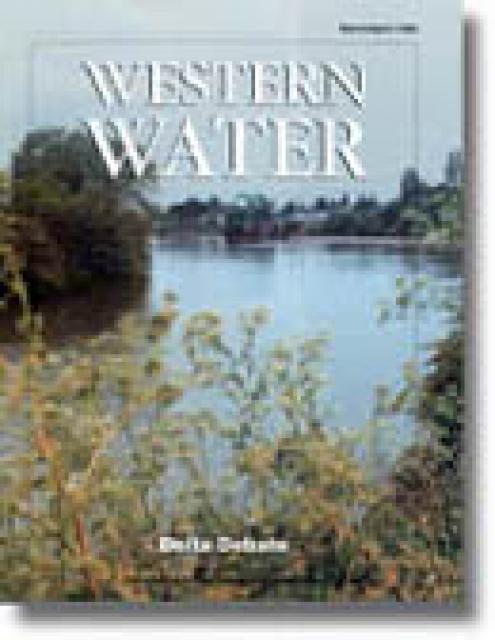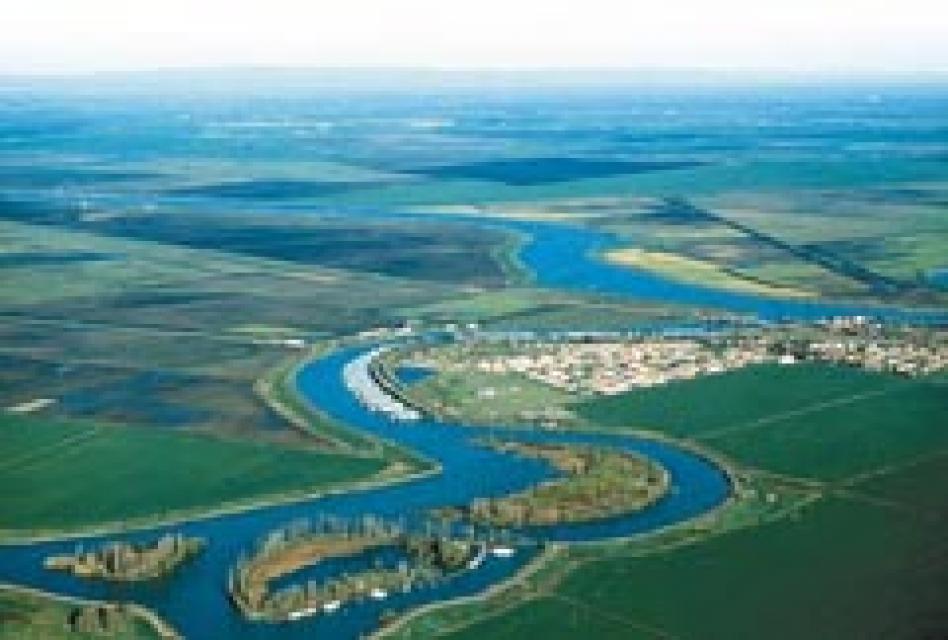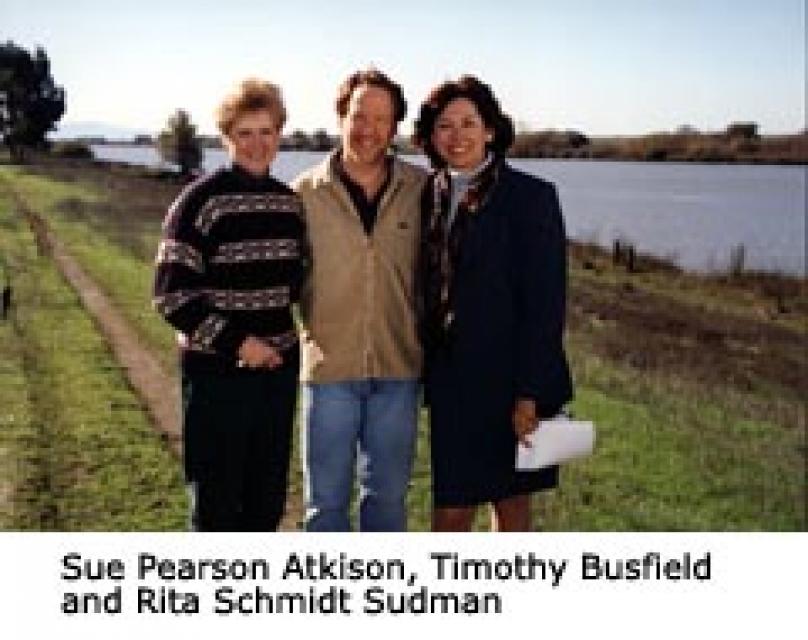Delta Debate
Mar/Apr 1998
Introduction
The quest to determine a long-term “fix” for the San Francisco Bay/Sacramento-San Joaquin Delta Estuary is at a critical juncture. Somehow, the familiar Delta debate must become a Delta decision as agency staff, stakeholders and the general public prepare to analyze the voluminous product of more than two years of study and discussion — CALFED’s Phase II draft programmatic environmental impact statement/report (EIS/EIR).
The document does not identify a preferred option as was once planned, although a technical analysis of the dual conveyance system — in which water would be moved north to south through a new isolated canal and existing Delta channels — shows that it has the potential to best address critical problems. The political and financial obstacles with such a solution are formidable, however, and it is these issues that began to drive the debate in the days leading up the March 16 release of the draft EIS/EIR.
The collaborative nature of the state-federal-stakeholder Bay-Delta process was designed to alleviate such conflict, and in its Phase II interim report, CALFED renewed efforts to focus attention on the programs common to each alternative. CALFED also stressed the need for public input and acceptance of the ultimate solution, which will require an assurances package to protect all resources.
“On the table is an array of alternatives; each has a set of tradeoffs to weigh. We have to discuss these drawbacks,” said Lester Snow, executive director of the CALFED Bay-Delta Program. “It may sound like a negotiating process to some but it is a classic analytical approach. There’s not a single action that you can take that doesn’t have some sort of an impact. More habitat for Delta smelt sounds good to everyone, but that will reduce ag land in the Delta.”
The debate over the best way to resolve environmental and water conveyance conflicts in California’s Bay-Delta — heart of the state’s surface water supply system — is not new. It stretches back more than two decades as agricultural, environmental and urban water interests, the main stakeholder groups, fought over how to allocate the Delta’s limited water resources. Other stakeholders include in-Delta water users, Sacramento Valley farmers and landowners, rural mountain counties, commercial and sport fishing groups and business leaders throughout California.
Whatever alternative ultimately is selected later this year, it will include a comprehensive package of measures to address water use efficiency, ecosystem restoration, water quality and levee rehabilitation, CALFED’s original four common programs. Shortly before the draft report was released, the state-federal cooperative effort added two new common programs: a watershed management coordination program and a water transfer policy framework. (These core programs vary little between alternatives.) Financing options, habitat priorities and an implementation plan will be determined with the preferred alternative.
At one point, additional storage was a distinguishing characteristic, but CALFED refined the alternatives so all include storage in an effort to focus on the most fundamental differences among the options. How many acre-feet of additional storage, where it will actually be developed and who will pay for it are far from determined. In summary, the three alternatives as developed by CALFED:
- Alternative 1. Re-operation of the existing system, with up to 6.25 million acre-feet of additional surface water and groundwater storage upstream and downstream of the Delta; flow barriers in the South Delta; new, large fish screen installed at the pumping plants; and construction of a new State Water Project (SWP)-Central Valley Project (CVP) intertie to allow for shared exports.
- Alternative 2. Construction of a new, shallow Delta channel isolated from Snodgrass Slough with large fish screen for improved flow of better quality Sacramento River water to SWP-CVP pumping plants; up to 6.25 million acre-feet of additional surface water and groundwater storage upstream and downstream of the Delta; McCormack-Williamson Tract floodway and habitat complex; set-back Delta levees; flow barriers in the South Delta; and construction of SWP-CVP intertie.
- Alternative 3. Construction of an additional open-channel isolated facility with screened intake from the Sacramento River to move water around the Delta to the pumps and users in adjacent counties; up to 6.25 million acre-feet of additional surface water and groundwater storage upstream and downstream of the Delta; installation of a new fish screen at SWP-CVP pumping plants; flow barriers in the South Delta; and construction of SWP-CVP intertie.
Consensus is the ultimate goal or, at the least, a solution that no one vigorously opposes. Getting there won’t be easy. Consider the 1994 Bay-Delta Accord. Although it was a consensus-driven agreement, it did not end the conflict over the Delta’s dual role as the hub of the water system and home to a wide variety of fish and wildlife, including several endangered species. Recent controversies have centered on the inclusion of $400 million for facility studies in a proposed water bond, implementation of the Central Valley Project Improvement Act (CVPIA), continued debate over how large a role agricultural land retirement should play in the solution, and a proposal to add three more chinook salmon runs to the endangered species list. For CALFED, the process has become a delicate balance of planning and politicking as it strives to keep the participants on course.
“The problem is we have stakeholder groups looking for things or who are against things and they are not looking at how to solve the problem,” Snow said. “For example, environmentalists dislike the storage component, water users like it. It becomes a symbolic fight. We at CALFED look at storage as a resource management tool, and in the end, we may not need as much storage or there may be no one willing to pay for it.”
Another overriding issue is the ghost of prior Delta proposals, in particular, the Peripheral Canal. That facility was identified as the best way to improve water quality and alleviate Delta project pump’s impacts on fish as early as the 1960s. Later planning efforts came back with the same solution and in 1982, there was a statewide referendum over the canal that divided California north against south.
“If there’s one thing 33 million Californians know … it’s the geopolitics of water in California and the Peripheral Canal. They know northern California has the rainfall and southern California has the people,” said Randele Kanouse, special assistant to the general manager at East Bay Municipal Utility District. “We need to face the Peripheral Canal issue head-on. For us to say, ‘This is not the Peripheral Canal and don’t call it that,’ is not the smartest way to continue. We need to bury the ghost of the Peripheral Canal and explain how this is radically different from what was talked about 20 years ago.”
CALFED points out that its dual system alternative is not the same as the Peripheral Canal, in which all export water would have passed through a structure twice as large as the facility now under consideration. The 1982 package, ultimately rejected by the state’s voters, did not include a comprehensive program of environmental enhancement or a commitment to assure its operation as intended. Nor did it contain the other components of the CALFED program.
Trust, however, remains a key factor in reaching consensus on a Bay-Delta solution and suspicion remains on all sides of the issue. “The obsession with storage and conveyance facilities that seems to be emerging from CALFED is highly unfortunate and appears to be heading us back to the great Peripheral Canal referendum of 1982,” said Tom Graff, senior attorney with the Environmental Defense Fund and a member of the Bay-Delta Advisory Council (BDAC).
Other environmentalists have pushed hard in recent weeks for a CALFED alternative with a stricter demand-side management option of water conservation, water transfers and the permanent retirement of hundreds of thousands of acres of San Joaquin Valley farmland.
Farm interests say large-scale farm land retirement has no place in a consensus-driven process. “Many in the ag community see environmental improvement as an investment in their future, too,” said Jason Peltier, manager of the CVP Water Association. “But when we don’t see that kind of open-minded understanding of the relationship between water supply and environmental improvement on the part of the environmentalists … it is increasingly difficult to believe and convince others in our community that the expectations and goals created by CALFED in this regard are being seriously undertaken by all stakeholders.”
For urban water suppliers, there is increasing concern over the quality of water exported or diverted from the Delta, especially in light of a recent study linking drinking chlorinated water with increased risk of miscarriages. Also, urban water leaders find many of their constituents are looking to CALFED to increase the size of the water “pie” through additional storage and transfers, with some complaining the proposed amount will not address the state’s projected supply-demand shortfall.
“It will probably take longer than anyone wishes, but the bottom line is failure is not an option,” said Byron Buck, executive director of the California Urban Water Agencies (CUWA) and a member of BDAC. “California water supply needs and water quality needs are growing. We may have huge blowups. None of the constituent groups has any choice but to get these things resolved. The failure mode is the worst possible outcome for everyone.”
This issue of Western Water follows release of the CALFED Bay-Delta Program’s draft programmatic EIS/EIR. The article describes the program’s process to date; examines key issues; provides an overview of the alternatives; and discusses what the future may hold as agency staff, stakeholders and the general public move forward to select a final alternative.
By Sue McClurg
Please contact the Foundation to purchase a full copy of this magazine.
Editor’s Desk
An important report on California’s water was released at the same time this magazine went to press. By now, many of you will have seen the voluminous document released by the CALFED Bay-Delta Program. We hope Sue McClurg’s summary of CALFED’s, three proposed alternatives, the common programs and list of pressing policy issues to consider in making this important decision will help Californians understand the risks and rewards associated with each alternative. It is, as this article emphasizes, a complex water problem with no easy solution. Further discussion on these alternatives will take place during the next few months as federal, state and local governments, the stakeholder groups and the general public debate the merits of each possible Delta “fix.”
One way we hope to help the general public understand the significance of the CALFED program is with the release of a soon-to-be completed public television documentary on the Delta. Tentatively titled Dividing the Waters: The Delta Decision, it is the program I described in my January/February letter. It will be hosted by Delta resident, Timothy Busfield, star of thirtysomething and Field of Dreams. Since a 1995 poll showed most Californians have no idea of the Delta’s physical location and strategic importance, this program should provide a public service. In fact, the program will open with a “man-on-the-street” session as people are asked where is the Delta. Watch for the program on your local public television station. A viewer’s guide will accompany the program.
With the release of the proceedings from our 75th Anniversary Colorado River Compact Symposium, the Foundation has launched a new Colorado River Project. Funded by a grant from the U.S. Bureau of Reclamation’s Upper and Lower Colorado River regions, the project will include a newsletter on Colorado River Basin issues. The first issue will appear in June. The grant also will underwrite a thorough update and expansion of our Layperson’s Guide to the Colorado River, our Lower Colorado River Tour (sign-ups are underway!) and planning for a major symposium to be held in 1999. Our overall goal is to expand upon the shared vision for the future of the Colorado River as discussed at the May 1997 symposium in Santa Fe.
Assisting us in this endeavor is our new writer at the Foundation, Josh Newcom. Josh replaces Elizabeth “Lizzy” McCarthy who has gone on to develop a freelance writing business. Josh is a graduate of Emory University in Atlanta and worked for The Atlanta Journal and Constitution for three years before moving out west. He’s already met his first Foundation deadline producing the “In the News” piece for this issue.
With our focus on dissension over water issues in the United States, we sometimes forget how safe and plentiful our water is compared to the situation in developing countries. That’s why I was gratified to join the board of Water for People. Headquartered in Denver, Water for People is a nonprofit organization that helps people in developing countries obtain safe drinking water.
In the News
Two studies released last month by the California Department of Health Services have put the drinking water spotlight back on trihalomethanes (THMs), a disinfection byproduct created when water’s naturally occurring organic matter (such as salt, soil acid and plant debris) react with chlorine.
The studies assert that pregnant women who drink five glasses of water with certain levels of bromodichloromethane — a THM formed from salty water like that found in the Delta Ð have a higher risk of a miscarriage. Two-thirds of the state’s water comes from the Delta.
The finding is of particular importance because it could be representative of an acute problem. For some time, THMs have raised health concerns among medical, water and urban communities because of their known existence as a carcinogen in animals. But even if THMs were proven to be carcinogenic to humans, they would present long-term health problems vs. the immediate problems suggested by the recent studies.
The nature of chlorine to form THMs, compounded with a federal clampdown on allowable THM levels in drinking water, has motivated many water districts around the state to drop their traditional practice of using chlorine as the preferred disinfectant.
Chloramine (chlorine and ammonia) and ozone are becoming the standard alternative water treatments, but both have drawbacks. Though chloramine reduces THM levels, it generally allows increased amounts of algae in the water. Ozone, which can cost up to three times the amount of traditional chlorine treatment, can produce the carcinogen bromate if the water being treated is high in bromide (salt). Since bromide is the culprit in the miscarriage studies and in ozone treatment, many say reducing bromide levels in the source water is the best answer.
Some water providers, including the Los Angeles Department of Water and Power and the Contra Costa Water District, already are treating their water supplies with ozone. Other districts, like the Santa Clara Valley Water District (SCVWD), which served as the target population for one study, have decided to expedite the upgrade of their treatment plants from chlorine to ozone.
Originally slotted for completion in 2005, SCVWD says it now plans to make the transition to ozone much sooner. A side effect of the accelerated upgrade will be higher water prices for consumers. But for the moment, SCVWD, like much of the water community, is remaining cautious about the study.
To allay concerns that the studies (and results) are area-specific, the U.S. Environmental Protection Agency (EPA) said a confirmation THM/miscarriage study will be conducted, this time in an altogether different geographic region. EPA said it is committed to continuing the investigation of THMs by examining factors which contribute to the formation of disinfection byproducts, evaluating water treatment technologies and continuing investigation of potential health hazards from disinfection byproducts including THMs. Additionally, EPA is conducting studies of 500 water utilities nationwide as a comparative analysis of THM levels in national water supplies.
Despite scientific skepticism over the studies, some water districts are advising pregnant women who generally consume large quantities of tap water to consult their doctor. Pregnant women may also inquire about THM levels directly from their water supplier or use additional water treatments to reduce THM levels. Water agencies say boiling water or using a charcoal water filter are viable methods of reducing THMs.
— by Josh Newcom







